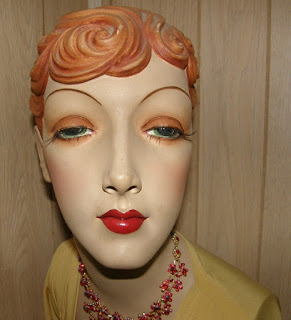ON A BIG NEW YORK DEPARTMENT STORE
INT. DEPARTMENT STORE WINDOW: ON THE MANNEQUINS INSIDE:
MILDRED: "Am I imagining it or is it getting even hotter in here?"
REGINALD: "Haw! Good old Mildred, always exaggerating."
NIGEL: "No, I feel it, too. My fingers are getting sticky."
GERTRUDE: "That's because you're made of wax. You should be plaster, like me. We don't melt so easy.
Of course, we flake when it gets hot ...like...er, um...now."
NIGEL (VO): "It's almost Summer. Mornings get hot now. I don't think the store knows what's happening here."
GLADIOLA: "I'd give anything to ditch this fur coat."
IRIS: "The hands in the glove display are made of 100% wax. I figure we're okay as long as they hold out."
ON THE DISPLAY: THE GLOVED HANDS POINT RIGIDLY AT AN IMAGINARY POINT O.S.
THEN, WITHOUT WARNING, THE FINGERS GO LIMP.
ALL (VO): (A collective gasp)
DAISY: "Well, that's it then. We're screwed."
DAISY(VO): "Paul, you seem to be taking this calmly."
PAUL: "Why not? there's no use in crying about what you can't change. Besides, I've always wondered what happens to creatures like us when the end comes."
PAUL (VO): "I guess I'm going to find out."
MILDRED (DEJECTED): "Yeah...find out."
DAISY: "Find out...."
BEHIND THE MANNEQUINS A DOOR SLIDES OPEN:
ART DIRECTOR: "What the heck!!??? What's going on here? Who's responsible for this!?????
ART DIRECTOR (VO) (TO HIS CREW): "Get those mannequins in a car fast!!! Turn the engine on! Crank the air conditioner all the way up!!!"
ON THE MANNEQUINS INSIDE THE VAN:
MILDRED: "Hey, we're in a van. Does anyone know how to drive it?"
REGINALD: "No, but if humans can do it, how hard could it be?"


























































